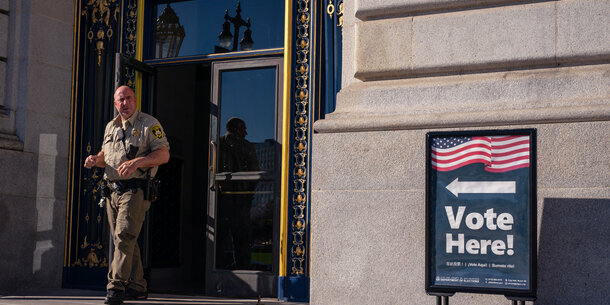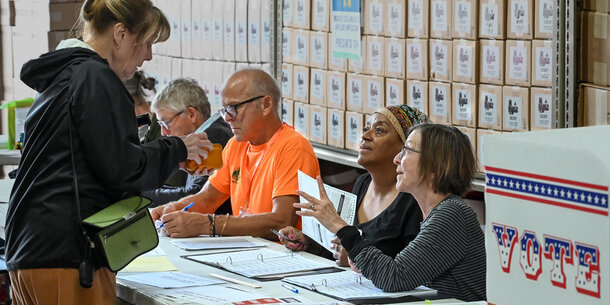President Donald Trump’s March executive order on elections has made headlines and drawn legal challenges, including from the Brennan Center. But the order is only part of his administration’s harmful election-related actions, and most of them are flying under the radar. Since taking office, the president has made a concerted, far-reaching effort to dismantle much of the federal support, funding, and infrastructure that has been built over the last decade to help states protect our elections from attack.
Just last week, the president ordered the Department of Justice to review the actions of Christopher Krebs, who Trump appointed to lead the Cybersecurity and Infrastructure Agency (CISA) in 2018. Krebs successfully oversaw the agency’s work to secure the 2020 election, but the president’s new memorandum now accuses him of misconduct for denying the false claims that the election was rigged. This targeting of an individual for criminal investigation sets a dangerous precedent for government officials who seek to do their jobs free from partisan considerations and who may need to push back against false election denial claims in the future.
What is the federal government’s role in securing election infrastructure?
While states are charged with administering safe and secure elections, the federal government has played a critical role in helping election officials protect the infrastructure of elections.
Election infrastructure encompasses a large range of election components, including voter registration databases, voting machines, IT systems, polling locations, and the staff who manages those components. The Department of Homeland Security designated election infrastructure as critical infrastructure in 2017 following Russian cyberattacks, a designation that provides states and localities with access to many of the cybersecurity protections that DHS offers other private and public entities, such as ongoing threat monitoring, risk and vulnerability assessments, and security best practices. CISA was created as a division within DHS in 2018 to protect critical infrastructure from physical and cyber threats.
Many other federal agencies have provided state and local election officials with support, and many of them have also been targeted in recent weeks. For instance, the Office of the Director of National Intelligence houses the Foreign Malign Influence Center, which works to protect elections from international propaganda and manipulation, including efforts powered by artificial intelligence. The FBI provides election officials with threat briefings and technical assistance with election-related systems and responds to foreign and domestic cyber and physical threats. The Department of Justice created an Election Threats Task Force in 2021 to address violence against election workers amid increased harassment and threats following the 2020 election. Additionally, the U.S. Election Assistance Commission creates voluntary standards for the security of voting systems and certifies them under a federally run program.
How has federal support for election security changed under the Trump administration?
So far, the administration has cut federal partnership in or funding of election security in four critical areas.
Cybersecurity support
CISA is the primary federal agency responsible for coordinating cybersecurity protections with states and localities, including for elections. Over the last several years, it has provided election offices nationwide with vital cybersecurity services to keep our elections safe and secure, such as threat intelligence briefings, cybersecurity assessments, incident response, vulnerability scanning, risk management training, intrusion detection and blocking systems, and cyber hygiene. In 2023 and 2024 alone, CISA conducted over 700 cybersecurity assessments for local election jurisdictions around the country.
In February, however, CISA froze all election security activities pending an internal review. The review was completed in March, but the Trump administration has said that the findings will not be released to the public. In the weeks since the review was completed, there has been no indication of whether any cybersecurity support has been restored.
It’s not just services that have been cut. CISA has lost much of its expertise in elections as well. In February, DOGE cut about 130 workers from CISA, including its election security advisers. These were state and local election administration experts who used their knowledge and experience to help state and local election officials get the resources and support they needed to administer secure elections. Additionally, many employees who worked on CISA’s foreign influence and disinformation teams were placed on administrative leave.
The recent dismissal of the head of the National Security Agency and U.S. Cyber Command has further concerned election security experts that our election infrastructure is now dangerously exposed to foreign and domestic cyber threats.
Physical security support
Eliminating CISA support also endangers the physical security of elections. CISA has provided resources and tools to help officials make election offices, voting locations, and tabulation centers safe, including assessments that evaluate the physical security of facilities, identify vulnerabilities, and offer recommendations on mitigating risks. Ahead of the 2024 election, CISA conducted nearly 1,300 physical security assessments for election stakeholders across the country, and many local election officials used that information to enhance their physical security measures.
These precautions helped election officials administer the 2024 election fairly and securely, even in the face of an array of physical threats, such as bomb threats, the destruction of ballot drop boxes, and the delivery of suspicious packages.
Information sharing
Given the United States’ highly decentralized election system, effective and coordinated information sharing between federal, state, and local entities is critical to preparing for and responding to security threats. However, the administration has now pulled funding from several entities that helped maintain this communication.
Last month, CISA terminated funding for the Election Infrastructure Information Analysis Center, a network that facilitates information sharing about security risks and best practices between election vendors and state and local election officials. Prior to the 2024 election, CISA and EI-ISAC were responsible for warning election officials about envelopes filled with white powder sent to election offices in at least 15 states.
CISA also cut funding for the Multi-State Information and Analysis Center, a similar network that serves all state and local government entities. It is unclear which of MS-ISAC’s services for election officials will remain.
Additionally, DHS terminated the Critical Infrastructure Partnership Advisory Council, which provided the private and public sectors with a protected forum for exchanging threat intelligence, developing cybersecurity policies, and examining risks. Without these legal protections, the private sector may be less willing to share vital threat-assessment information with the federal government.
State and local election offices typically have limited resources and are unable to conduct the kind of sophisticated risk monitoring of which the federal government is capable. Without that information, election officials will be far more limited in their ability to identify emerging attacks or coordinate responses to such threats with local agencies.
Foreign interference deterrence
Foreign nation-states have engaged in cyberattacks and influence operations in every federal election since 2016. The Office of the Director of National Intelligence and the FBI warn that China, Iran, and Russia continue to build their capacities to attack our elections in the future. Going forward, it is unclear what the federal government will do to respond to foreign interference in our elections, but the administration has already scaled back our defenses significantly.
Without the federal government’s help in tracking, probing, and disrupting foreign interference, and with reduced information sharing among key stakeholders, election officials might not be aware of or prepared for foreign threats. Disruptions caused by these threats could sow doubt and confusion among voters about the safety of their vote and the accuracy of election results.
Will the administration continue withdrawing federal support for election security?
Further cuts and policy changes that weaken election security are quite possible. Project 2025’s policy agenda for a conservative administration recommended a radical restructuring of key federal agencies that have a hand in election security, and that is exactly what we have seen in the first few months of the Trump administration. Given the breadth of actions described in Project 2025, there is reason to fear there will be even more harmful measures in the coming months and years.
How are the administration’s actions on election security affecting election officials?
All the cuts discussed above are damaging in their own right, but the underlying fear is that they have eroded trust between election officials and federal agencies. That trust has been critical to any successful election security partnerships between federal, state, and local governments in the past. The lack of clarity from the administration on how deep such cuts may go is also a problem, as many election officials are unsure about the future of federal election security support as they plan for upcoming elections.
This uncertainty is especially alarming for states that have state or local elections slated for this year, such as Arizona and Pennsylvania. Arizona Secretary of State Adrian Fontes said that election officials “are effectively flying blind” without CISA’s assistance and resources. Pennsylvania Secretary of State Al Schmidt wrote in a letter to Defense Secretary Kristi Noem that the rollback of CISA’s services will have “serious consequences” for local election officials.
Meanwhile, President Trump’s executive order on elections, which the Brennan Center is challenging in court, further jeopardizes election security by instructing the U.S. Election Assistance Commission to abruptly amend the voluntary federal guidelines for voting machines without going through the processes mandated by federal law. However, no voting system has yet been certified to meet the guidelines outlined in the executive order. While there is good reason to believe the executive order will be blocked by the courts, this too adds uncertainty for election officials.
What can states do to protect elections amid reduced federal support?
Regardless of what happens next, states — which actually run our elections — and civil society will need to step up to fill the gaps the federal government has left. Possible solutions include increasing funding for election infrastructure, supporting cyber and physical security best practices, and promoting better information sharing within and between the states. With the midterm elections coming next year, the time to start preparing is now.






